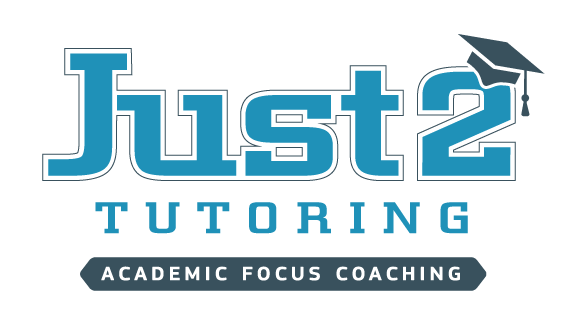How to Study, A Simple Study Plan
Recently, new online student contacted Just2 Tutoring. A high school Junior, she stated between tears, “I’m just not good at taking tests”. I appreciated her honesty and vulnerability. I don’t believe that it was a lack of instruction on the part of her teachers, as any experienced teacher will explain that their lessons are thick with overlapping instruction, covering both content and organization of study material.
However, many students, especially those challenged by executive functioning or focus issues, will argue that little more than completing assignments is required for success. Assessment preparation is reduced to “looking over notes” and a student may eventually convince themselves and others that they will never perform well in an assessment setting.
In the event of an emotional reaction to academic stress, minds often close to solution. Students require support but might not even think to access services. Ultimately, students, much like this Junior, can be coached to become their own best support when provided with simple, ritualized, study guidelines which best suit them.
Just about every student we have seen who reports consistent testing challenges has turned out to be a student who lacked a clear study plan. Simpler is better when it comes to having an action plan for studying.
Study strategy, applicable across various courses and content, is the foundation on which students develop practices which drive testing confidence and success.
A simple study plan that I suggest consists of the following:
- terms
- readings
- self-assessment.
Terms.
We all know the power of the word. The first step in any study plan is to create a context. Think of a setting, such as a sandwich shop, a fishing pier, or a sporting event. There is a specific box of words, or terms, that will pour into the front of your brain. This relevant vocabulary allows conceptual interaction within a context and with the people who we find in these settings.
Effective study requires context. The practice of mastering terms and vocabulary provides this context and with significantly greater clarity when a student engages in the second step of the J2 simple study plan: complete relevant readings.
Prior exposure, and ideally a mastery of terms allows for a more meaningful interaction with text content or research materials. It reduces the chance of seeing an unfamiliar word within the text and guessing its meaning purely on context. As subject matter increases in its complexity, a student who reads without prior knowledge of relevant terms will find themselves faced with the double whammy of both not grasping the material, and not having any contextual or background knowledge.
Read.
In my practice, I have learned to ask the most basic of questions. By asking a question, rather than lecturing a student, we are able to best guide our youth. Instead of simply asking about the completion of an assignment, I have learned to ask the next logical question: has it been turned in?
Even in the case of high performing students, I have learned to ask, “Have you read the chapter?” I would be willing to bet that many teachers and professors would be disappointed to hear that many students, despite their teacher’s best efforts to give assignments to facilitate textbook interaction, will often make elaborate efforts to avoid the act of reading each page. Many students feel that they just don’t have the time to engage in every reading, illustration, and chart.
Through the daily practice of time management, accountability and incentives, we see students effectively engage with their study materials. Students are coached to know how they learn best and interact with their coursework each day even in the absence of daily assignment.
At this point, students have attended class, completed assignments, studied their terms and read the chapter. The next and most important part of a study plan is what offers evidence of comprehension, retention and recall. An interactive method of test practice offers a more accurate prediction of assessment performance.
Self-Assess.
Too frequently, we hear a student state that the upcoming assessment is “pretty straightforward,” or “no big deal.” When pressed about tools and approaches for assessment preparation, they’ll often state that they simply “looked over the material.”
One of the greatest benefits of working with Just2 Tutoring is improved relationships at home. With self-assessment as a consistent part of a study plan, parents and students, who had formerly battled over the subject of assessment preparation, are often able to find common ground. The most effective method of assessment preparation can take a variety of forms. Online textbook assessments, academic web sites, such as Quia and Quizlet, and teacher provided study guides with accompanying answer keys are some examples of self-assessments. Students should share their study plan with their teachers and always verify the format and scope of the upcoming test.
It is far too easy to convince oneself that you “know the material.” For ensured success, reduced test anxiety, and dramatically improved test performance, self-assessment is critical in the days leading up to the test.
Any former or current student of Just 2 Tutoring when asked what their study plan is, would confidently respond, “Master terms, complete reading assignments and relevant research, and arrange self-assessment opportunities.”
Contact Just2 Tutoring today for more information on how you can improve your study skills, time management and organizational skills.
‘s
Assignments, duh
Self Assess




